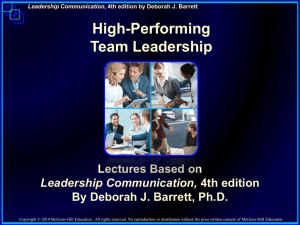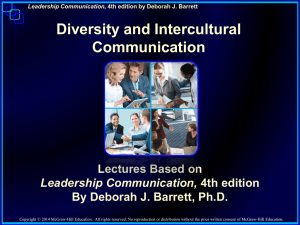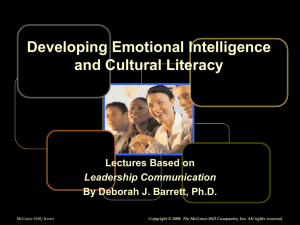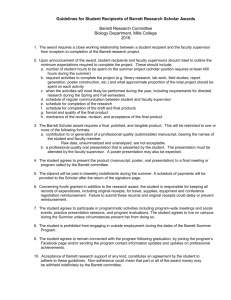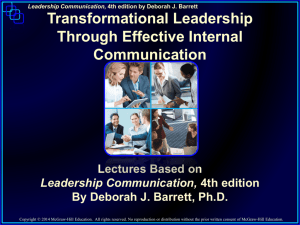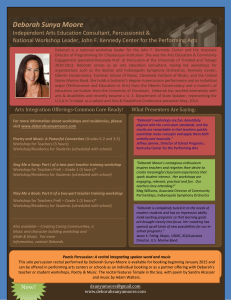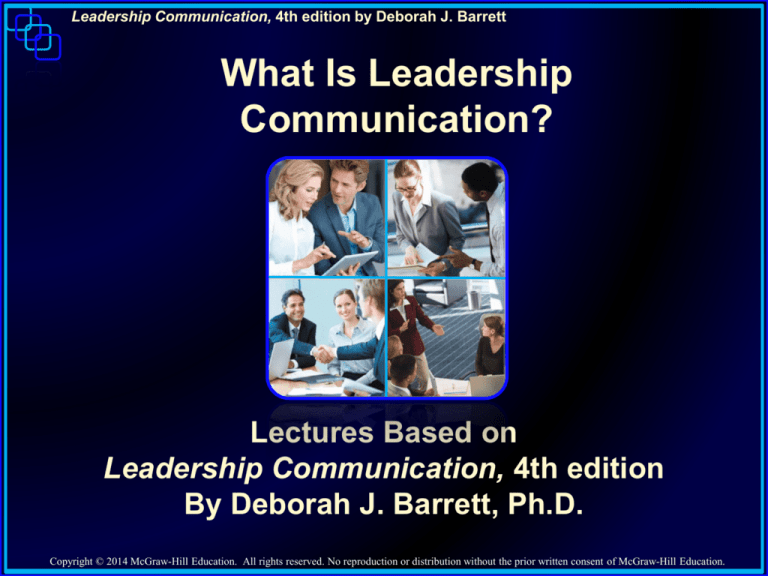
Leadership Communication, 4th edition by Deborah J. Barrett
What Is Leadership
Communication?
Lectures Based on
Leadership Communication, 4th edition
By Deborah J. Barrett, Ph.D.
Copyright © 2014 McGraw-Hill Education. All rights reserved. No reproduction or distribution without the prior written consent of McGraw-Hill Education.
Leadership Communication, 4th edition by Deborah J. Barrett
Discussion Topics
Leadership definitions and characteristics
Definition of leadership communication
Ways of projecting a positive ethos
Approaches to ethical decision making
1-2
Leadership Communication, 4th edition by Deborah J. Barrett
Leaders Inspire, Do, and Connect
Leaders guide, direct, motivate, or inspire others
Leaders are the men and women who do some
or all of the following:
Influence others in an organization or
in a community
Command others’ attention
Persuade others to follow them or pursue
goals they define
Control situations
Improve the performance of groups and
organizations
Leaders connect with others and get results
1-3
Leadership Communication, 4th edition by Deborah J. Barrett
Leadership is Defined by Traits and Actions
Leadership theorists define leadership by
The traits—key characteristics, personality,
and charisma—leaders possess
The tasks they perform
The positions they hold
The accomplishments they achieve
1-4
Leadership Communication, 4th edition by Deborah J. Barrett
Transformational Leaders are
Visionary and Inspirational
Transformational leaders
Articulate a clear and motivating vision
Inspire trust and respect
Connect with others individually and in groups
Skillfully motivate and guide others to act
Possess a positive ethos (authority and
credibility)
1-5
Leadership Communication, 4th edition by Deborah J. Barrett
Leaders Rely on Different Sources of
Power to Influence Others
Types
Definitions
Coercive
Prospect of being punished
Reward
Prospective benefits or rewards
Legitimate Power Recognized title or position in organization
Referent
Personal attractiveness and charisma
Expert
Having knowledge, skills, and expertise
Information
Possessing need information
Connection
Interpersonal and network linkages
Sources: French & Raven (1958). “The Bases of Social Power.” in
Studies in Social Power; Hocker & Wilmot (2013). Interpersonal Conflict.
1-6
Leadership Communication, 4th edition by Deborah J. Barrett
Leaders Use all Appeals to Influence Others
Aristotle’s
Persuasive
Appeals
Appeal to
emotions
Appeal based
on credibility
Appeal
based in
logic
1-7
Leadership Communication, 4th edition by Deborah J. Barrett
But a Positive Ethos is Most Important
Positive Ethos
1-8
Leadership Communication, 4th edition by Deborah J. Barrett
Three Primary Methods for
Creating a Positive Ethos
Aristotle argued that a
communicator can create a
positive ethos by
1.Ensuring all messages are
“worthy of belief”
2.Making his/her “own character
look right”
3.Putting the audience into the
“right frame of mind”
1-9
Leadership Communication, 4th edition by Deborah J. Barrett
Ensuring Messages are Worthy of Belief
Make messages
meaningful, clear,
and logical
Have all of the facts
in hand
Be honest and
ethical
Avoid careless errors
1-10
Leadership Communication, 4th edition by Deborah J. Barrett
Making Own Character Look Right
Dress the part
Project confidence
Know the subject
and be prepared
Take time to build
a rapport
Avoid common
delivery mistakes
1-11
Leadership Communication, 4th edition by Deborah J. Barrett
Putting Audience in the Right
Frame of Mind
Affirm cultural values
Be sensitive to
context
Understand their
needs and
motivations
Frame messages
carefully and target
them specifically
1-12
Leadership Communication, 4th edition by Deborah J. Barrett
Leadership Depends on Communication
“Effective leadership is still largely a matter
of communication. . . . An effective leader
thinks about what he says, carefully crafting
each utterance of any significance.”*
Effective leadership depends
on effective communication.
*Axelrod, A. Elizabeth I CEO: Strategic Lessons from the Leader
Who Built an Empire.
1-13
Leadership Communication, 4th edition by Deborah J. Barrett
Communication Seems Simple
Context
Message
Medium
Sender
Receiver
1-14
Leadership Communication, 4th edition by Deborah J. Barrett
Interferences Often Prevent
Successful Communication
Message
Inappropriate context
No audience analysis
Muddled thinking
Wrong medium
Wrong spokesperson
Poor usage or style
Poor timing
Questionable ethics
Sender
Unclear message
Illogical structure
Poor formatting
Offensive tone
Cognitive dissonance
Cultural
misunderstandings
Negative ethos
Receiver
1-15
Leadership Communication, 4th edition by Deborah J. Barrett
What is Leadership Communication?
Leadership communication is the controlled,
purposeful transfer of meaning by which
individuals influence a single person, a group,
an organization, or a community
Leadership communication requires using the
full range of communication abilities and
resources to
Connect positively with audiences
Overcome interferences
Create and deliver messages that guide,
direct, motivate, or inspire others to action
1-16
Leadership Communication, 4th edition by Deborah J. Barrett
Leadership Communication Spirals Outward
1-17
Leadership Communication, 4th edition by Deborah J. Barrett
Ethics Consists of Values, Norms, Standards
From Webster’s:
“A set of moral principles or values”
From Trevino & Nelson’s Managing
Business Ethics:
Ethical behavior in business is
“behavior that is consistent with the
principles, norms, and standards of
business practice that have been agreed
upon by society.”
1-18
Leadership Communication, 4th edition by Deborah J. Barrett
The Legal System and Societies Help
Determine Professional Ethics
The legal system
Laws and regulations
International trade agreements
Contracts
Tradition, industry, culture
Professional codes of conduct
Company codes of ethics
Policy statements
Company values statements
Moral values
1-19
Leadership Communication, 4th edition by Deborah J. Barrett
Standard Approaches to Ethics
Influence Decisions
End Results (Consequentialist) – focuses on
harms and benefits to stakeholders to produce
greatest good for the greatest number
Duty (Deontological) – emphasizes duties, rights,
and justice, based on moral standards,
principles, and rules
Social contract (Group Virtue) – bases decisions
on customs and norms, the character and
integrity of the moral community
Personal (Individual Virtue) – bases decisions on
the conscience, what feels right
1-20
Leadership Communication, 4th edition by Deborah J. Barrett
Hosmer Provides a Useful Approach to
Ethical Decision-Making
Content Source: L.T. Hosmer. (2003). The Ethics of Management.
New York: McGraw-Hill.
1-21
Leadership Communication, 4th edition by Deborah J. Barrett
Discussion Summary
Leaders are individuals from all walks of life who
inspire others, transform situations, and bring
about positive changes for their community
Leaders may call on different sources of power
to influence others and achieve their goals but
all of what they accomplish requires effective
communication
Leadership communication proficiency begins
with core skills and expands outward to
organizational and broader external abilities
A positive ethos is a leader’s most persuasive
appeal, particularly if grounded in high ethical
standards and integrity
1-22


